ISSN ONLINE(2278-8875) PRINT (2320-3765)
ISSN ONLINE(2278-8875) PRINT (2320-3765)
Kiranmai.K1, Kishore Kumar.M2
|
| Related article at Pubmed, Scholar Google |
Visit for more related articles at International Journal of Advanced Research in Electrical, Electronics and Instrumentation Engineering
Today Robotics plays an integral role in all aspects of manufacturing, medicine, industries, home basic and more and it will take on even greater importance in the future. Controlling the robot by using GSM Module is a most suggested mechanism for mobile robot which has the capability of changing directions for the long range distances. In this design, fire detection and controlling method using robot is proposed. Fire is detected using the fire sensor and immediately SMS is sent to the user by using the GSM module. Then the user can control the robot by using GSM Module from remote location. The robot also detects the obstacles while moving by the obstacle sensor.
Keywords |
| Control architecture, GPS, GSM, Motor, Obstacle Sensor, Robot |
I. INTRODUCTION |
| Now-a-days, Robotics is used in each and every field of science and had gained much importance in day to day life. Recently, more and more research takes interest in the robot which can help people in our daily life, such as service robot, office robot, security robot, and so on. We believe that robot will play an important role in our daily life in the future, especially security robot. In the previous methods robots are controlled by using the RF remote control, Bluetooth, Wi-Fi, etc. But, using of these methods is limited to certain areas, and also very difficult to design. Generally, the robots are geographically distributed, often in the remote sites, the life span of the robot is important. Electrical energy and electrical conservation are very important roles in extending the lifespan of robots. During the RF transmission Robot consumes more power. To limit the amount of power used, an optimal communication should be done, taking into account amount of data; the battery level of the robots and the destination. |
| To overcome these difficulties, we have come up with a Mobile Controlled Robot by using GSM module. A Mobile Controlled Robot is a mobile device, which provides wide-range of wireless control ability to your robot unless your cell phone gets out of signal. A general concept of mobile controlled robot is that it can be controlled from any part of the world. The main objective of this project is the design of a fire fighting robot which detects the fire event by using the fire sensor and informs the user through a GSM module and the user can control the ROBOT by using the GSM module. The robot can detect and handle the obstacles as well by the use of Obstacle sensor. |
II. RELATED WORK |
| The robotic technologies development with each passing day, robot systems have been widely used in many applications. Nowadays, robot systems have been used in factory automation, dangerous environments, hospitals, surgery, entertainment, space exploration, farmland, military, security system, and so on. During 60’s the first industry and research group of robots is formed, manufacturing plants were started and from then robotics became very significant. Controlling robots from a distance, referred to as telerobotic. Tele robotics is a field of robots in which there are several tasks for humans to execute such as planning, manipulation etc., which means that there is a person acting behind instead of the control system. We cannot always satisfy the requirements of the control system especially in case of mobile robots [1].In recent days, Smart homes are becoming popular where all devices can be controlled digitally with a single device by using wireless technologies. In this technology as the number of the smart devices increases it is mandatory for the manufacturer to prepare a universal standard [3]. Many researches are done on remote controlling of robots. The COMMBOT project combines robotic and M2M fields, for achieving a real-time telemetry over a GPRS network. COMMBOT constitutes of two components. Firstly, Microbots that are used to obtain and measure data by sensing and transferring images to a central control station that allows user to monitor and control the Microbots remotely. Secondly, Microbots proxy is used for the management of the wireless communication between the Microbots and the control station [2]. |
| Loss due to fire damage has always been a major area of concern for both industrial and residential areas. In general, the fire detection device is fixed on the wall or ceiling, but the method is not flexible to detect fire event and it is not very convenient to use many fire detection modules in real time. To overcome all the above mentioned difficulties, we design a fire fighting robot which detects the fire event and informs the user through a GSM module. The robot can detect and handle the obstacles as well. |
III. PROPOSED METHODOLOGY |
| A mobile Controlled Robot is a mobile device, which provides wide-range of wireless control ability to the robot. In this design, fire detection and controlling method is proposed. A block diagram of the proposed supervising robot using GSM module is shown in Fig.1. Fire is detected by the fire sensor, these sensed signals are conditioned and given to the controller circuit and also the exact fire location information is sensed through the GPRS system to the controller. Immediately an SMS that consists of latitude & longitude values of the fire is sent to the user by the GSM module. |
| User can control the robot by the use of GSM module i.e., through SMS. A motor is used for driving the robot i.e., whenever the signals are given by the user the robot moves forward, backward, right, left with the help of the motor. When the robot reaches the exact location of fire accident, a water pump which is already connected to the robot sprinkles the water on the fire & the fire gets extinguished. An L293D motor driver is used for driving the motor and to step up the voltage from 5v to 12v. The relay circuit is used to driving the water and for to step up the voltage from 5v to 12v the voltage. |
| UART is usually an individual (or part of an) integrated circuit used for serial communications over a computer or peripheral device serial port. |
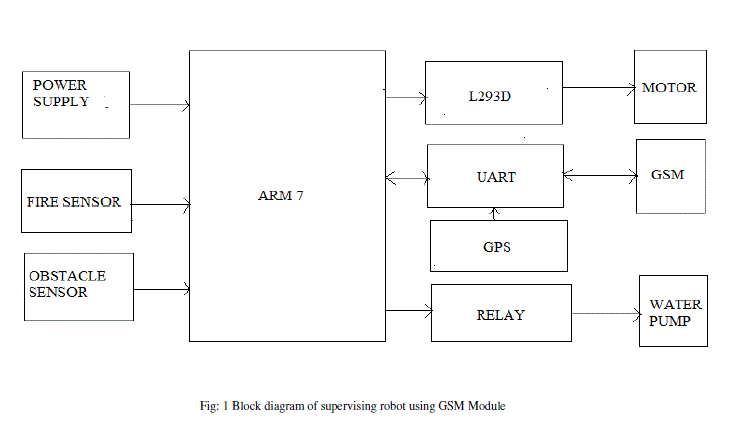 |
| A. GSM-GPS Architecture |
| GSM (Global System for Mobile communications) is an open, digital cellular technology used for transmitting mobile voice and data services. GSM supports voice calls and data transfer speeds of up to 9.6 Kbit/s, together with the transmission of SMS. GSM uses narrowband TDMA, which allows eight simultaneous calls on the same radio frequency. In the traditional GSM, data transmission is done using Circuit Switched Data (CSD) techniques whereby the network allocates one radio channel to a MS when data is to be transmitted to the network and the radio channel remain occupied for the connection time. |
| GPRS technology is used in this project to connect the MGM1 to the internet. It was also intended to use it for data and pictures transfer from MGM1 to mobile phones. In GPRS, data is the form of packets and it is transmitted through the air interface only when the need arises. The implementation of GPRS in the GSM architecture can be achieved by adding two new nodes: the Serving GPRS Support Node (SGSN) and the Gateway GPRS Support Node (GGSN). GPRS will be able to offer data rate up to 171.2kbps, but currently it is limited to 48kbps (Portolani, 2004). Figure 2.2 shows a GSM-GPRS network. |
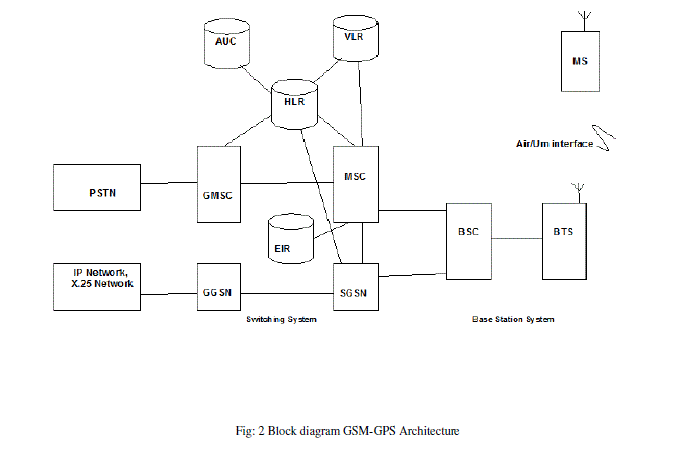 |
IV. RESULTS |
| A. The below figure shows the prototype of the Design and Implementation of supervising the Robot by using SMS |
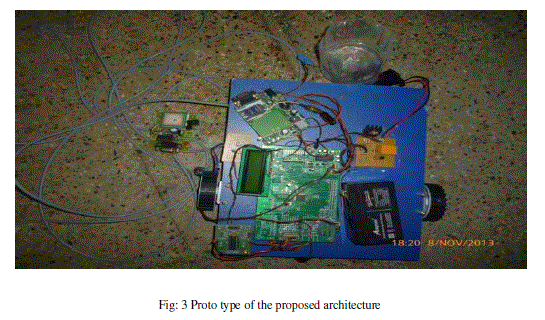 |
| B. The below figure shows that the Robot detected the fire and the longitude & latitude values of the place of occurrence of fire are sent to the controller through GPS receiver system. The longitude and latitude values are displayed on the LCD display. |
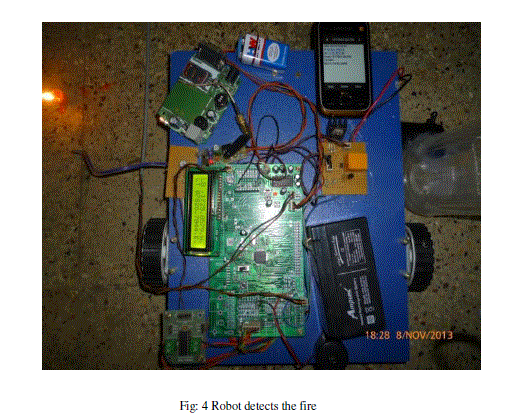 |
| C. The below figure shows the fire is detected & message has been sent on the display. this can displayed only when the Robot detected the location of the fire and longitude and latitude values of the corresponding fire detected area are sent to the user through GSM module. |
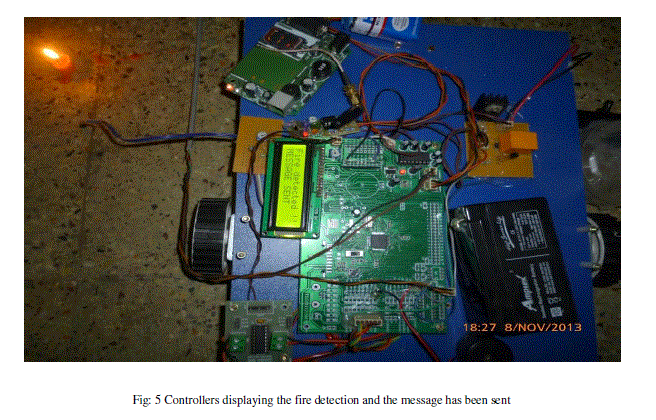 |
| D. The below figure shows the message about the longitude and latitude values of the fire detected area that was sent to the user mobile from the stored number in the Robot controller section through the GSM module. |
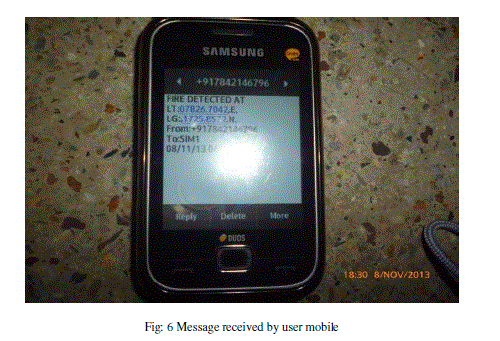 |
| E. The below figure shows the robot is moving to the front direction towards the fire located area and also at the same time the message like ‘Robot moving front’ also sent to the user mobile. |
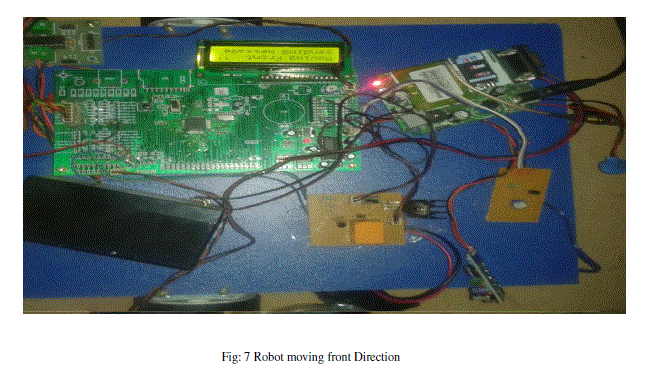 |
V. CONCLUSION |
| In this paper we have proposed a model of supervising the robot for fire extinguishing by using a GSM/GPRS system. We have also used an obstacle sensor for detecting the obstacles. The robot is mainly moved, on the directions given by the user through SMS. The power consumed by the robot in this model will be very low because of the usage of wireless remote control. The future scopes of this paper are the robot can be moved much efficiently if CC cameras are fixed and The robot can also be monitored and moved through internet also i.e., by using wifi instead of using a GPS. |
References |
|